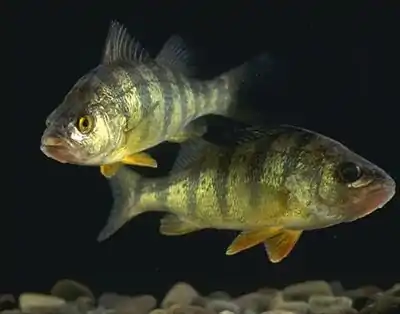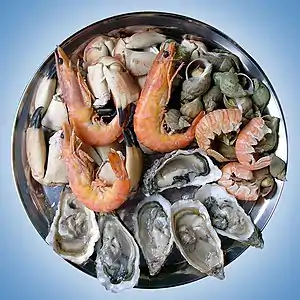Perch
Perch is a common name for fish of the genus Perca, freshwater gamefish belonging to the family Percidae. The perch, of which three species occur in different geographical areas, lend their name to a large order of vertebrates: the Perciformes, from the Greek: πέρκη (perke), simply meaning perch, and the Latin forma meaning shape. Many species of freshwater gamefish more or less resemble perch, but belong to different genera. In fact, the exclusively saltwater-dwelling red drum is often referred to as a red perch, though by definition perch are freshwater fish. Though many fish are referred to as perch as a common name, to be considered a true perch, the fish must be of the family Percidae.
| Perches | |
|---|---|
 | |
| Yellow perch (Perca flavescens) | |
| Scientific classification | |
| Kingdom: | Animalia |
| Phylum: | Chordata |
| Class: | Actinopterygii |
| Order: | Perciformes |
| Family: | Percidae |
| Subfamily: | Percinae Rafinesque, 1815 |
| Genus: | Perca Linnaeus, 1758 |
| Type species | |
| Perca fluviatilis Linnaeus, 1758 | |
| Species | |
| |
The type species for this genus is the European perch, P. fluviatilis.
Species
Most authorities recognize three species within the perch genus:
- The European perch (P. fluviatilis) is found in Europe and Asia. This species is typically greenish in color with dark vertical bars on its sides with a red or orange coloring in the tips of its fins. The European perch has been successfully introduced in New Zealand and Australia, where it is known as the redfin perch or English perch. In Australia, larger specimens have been bred, but the species rarely grows heavier than 2.7 kg (6 lb).
- The Balkhash perch (P. schrenkii) is found in Kazakhstan, (in Lake Balkhash and Lake Alakol), Uzbekistan, and China. It is very similar to the European perch, and grows to a comparable size.
- The yellow perch (P. flavescens), smaller and paler than the European perch, is found in North America. In northern areas, it is sometimes referred to as the lake perch. This species is prized for its food quality and has often been raised in hatcheries and introduced into areas in which it is not native. Yellow perch are almost identical in appearance to European perch, but have a more yellow coloring. These fish typically only reach a size of about 38 cm (15 in) and 1 kg (2 lb 3 oz).
Anatomy
The general body type of a perch is somewhat long and rounded. True perch have "rough" or ctenoid scales. On the anterior side of the head are the maxilla and lower mandible for the mouth, a pair of nostrils, and two lidless eyes. On the posterior sides are the opercular series, which protect the gills, and the lateral line system, which is sensitive to vibrations in the water. The kidney of the perch runs along the backbone and forms a head, caudal to the gills.[2] Perch have paired pectoral and pelvic fins, and two dorsal fins, the first one spiny and the second soft. These two fins can be separate or joined.
Habitats
Perch are carnivorous fish most commonly found in small ponds, lakes, streams, or rivers. These fish feed on smaller fish, shellfish, or insect larvae, but can be caught with nearly any bait. They commonly spawn during the spring, when the females lay strings of eggs in covered areas such as near branches or underwater plants. Perch have a wide distribution throughout the world, and are very plentiful in the Great Lakes, especially Lake Erie.
Fishing
Perch are a popular sport fish species. They are known to put up a fight, and to be good for eating. They can be caught with a variety of methods, including float fishing, lure fishing, and legering. Fly fishing for perch using patterns that imitate small fry or invertebrates can be successful. The record weight for this fish in Britain is 2.81 kg (6 lb 3 oz), the Netherlands 3.05 kg (6 lb 11 1⁄2 oz),[3] and in America 2.83 kg (6 lb 4 oz).
Perch grow to around 50 cm (20 in) and 2.3 kg (5 lb) or more, but the most common size caught are around 30 cm (1 ft) and 450 g (1 lb) or less and anything over 40 cm (16 in) and 900 g (2 lb) is considered a prize catch.
See also
- For other perch not in the genus Perca, see Perch (disambiguation).
References
- "Perca Linnaeus 1758 (perch)".
- Weatherley, A. H. (1963-03-01). "A Note on the Head Kidney and Kidney of the Perch Perca Fluviatilis (linnaeus), with Special Reference to the Blood Vascular System". Proceedings of the Zoological Society of London. 140 (2): 161–167. doi:10.1111/j.1469-7998.1963.tb01859.x. ISSN 1469-7998.
- https://beet.nl/record/nederlands-record-baars-56-cm/

